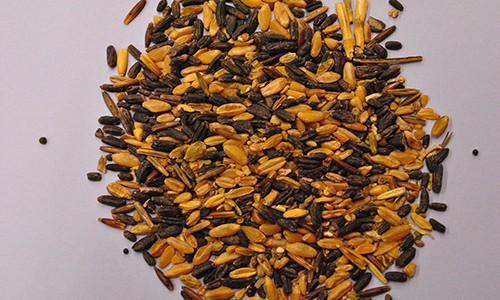
Definitive diagnosis
A U of S research team is working to develop a test that will allow veterinarians to make a definitive diagnosis of ergot poisoning in live animals.
By Jair GobbettEvery summer a vast mosaic of grain crops blossoms across the Canadian prairies.
But once they begin flowering, these plants become susceptible to Claviceps spp., fungi that are the source of major problems for the agriculture industry and the focus of a Western College of Veterinary Medicine (WCVM) research study.
The two researchers — veterinary pathologist Dr. Ahmad Al-Dissi and his graduate student, Dr. Rossalin Yonpiam — are investigating ergot, a fungal disease caused by Claviceps spp. that affects grain crops and various grasses.
When cattle and other livestock continually ingest feed that contains a high concentration of ergot alkaloids (toxic molecules), this results in serious health issues for the animals such as gangrene and decreased milk production. Low concentrations of ergot can significantly affect the growth and reproduction of livestock.
Right now a diagnosis of ergot poisoning depends on finding high concentrations of ergot within feed.
“But the concentration of ergot alkaloids within feed is not uniform,” says Al-Dissi. “It is often subject to significant variation due to mixing of new and old batches and due to weather conditions — resulting in misdiagnosis.”
Instead of relying on feed testing, Al-Dissi’s research team is working to develop a test that will allow veterinarians to make a definitive diagnosis of ergot poisoning in live animals or in their tissues — something that’s not available yet.
The issue of ergot-contaminated animal feed has been steadily growing in Western Canada during the past few years, says Dr. Barry Blakley, who supervises the toxicology lab at Prairie Diagnostic Services (PDS), the provincial veterinary laboratory for Saskatchewan.
Although grain screening effectively removes sclerotia (ergot bodies) from large loads of grain, the fungal disease still reaches livestock because pelleted grain screenings are a popular source of low-cost feed. Since the ergot alkaloids become concentrated during the screening and pelleting process, it’s critical for producers to test feed for ergot levels before using it.
Most days of the year, Blakley receives one or more calls about ergot. PDS receives feed samples for ergot testing every single week, and the dry weather in 2015 didn’t cause a reduction in the submission rate. Last year, the laboratory identified 367 feed samples containing potentially toxic concentrations of ergot (more than 200 parts per billion).
“The diagnostic lab saw more requests for analysis in the month of June 2015 than we ever have in any other month,” says Blakley, who is also a professor of veterinary toxicology at the WCVM.
While increased awareness has virtually eliminated cases of severe ergot toxicity resulting in the death of livestock, researchers are only beginning to recognize the more subtle effects of chronic low doses on livestock health.
“It’s not enough to cause gangrene, but the milk production is down and the growth of animals is reduced,” says Blakley.
One of the most concerning effects of ergot toxicity is abortion: high doses of ergot will cause abortion by inducing contraction of the uterus. Researchers also suspect that chronic low doses can cause fetal death at early stages of pregnancy. While they’re still unsure of the mechanism by which this occurs, it’s likely related to the constricting effects of ergot on the blood vessels of the mother’s placenta.
Although veterinarians recognize these clinical signs, it’s difficult to confirm that ergot toxicity is responsible for causing the animals to be sick.
Al-Dissi and Yonpiam hope to find a solution to this problem. In their study’s initial phase, the WCVM scientists exposed sheep to varying doses of ergot by feeding pellets of known ergot concentrations. For the following 12 hours, research team members collected multiple blood samples for lab analysis.
These samples will eventually help researchers develop and refine an appropriate analytical technique to detect the presence of ergot alkaloids in tissues.
The ability to detect ergot concentrations in an animal’s blood sample will help researchers gain a better understanding of how the toxins interact with the body, plus the knowledge could contribute to the development of potential treatments. A definitive test will also minimize the misdiagnosis of ergot toxicity.
In the study’s second phase, researchers will examine the chronic effects of ergot on pregnant ewes. They will feed low doses of ergot to a group of sheep over a prolonged period of time and then monitor them for the incidence of abortion.
Ideally, researchers will adapt the diagnostic tools developed in the study’s first phase to detect ergot alkaloids in the aborted tissues, providing veterinarians with a way to confirm ergot as the cause of abortion.
If the research study is successful, the findings will give researchers a better understanding of the health problems caused by ergot along with the ability to identify which animals are suffering from ergot toxicity. A test will also help to prevent further cases of the disease on individual farms — resulting in healthier, more productive livestock.
The WCVM research project received financial support from Saskatchewan’s Agriculture Development Fund and the college’s Interprovincial Undergraduate Student Summer Research program.
Jair Gobbett of Grand Forks, B.C., is a third-year veterinary student who was part of the WCVM’s Undergraduate Summer Research and Leadership program in 2015. Jair’s story is part of a series of stories written by WCVM summer research students.
